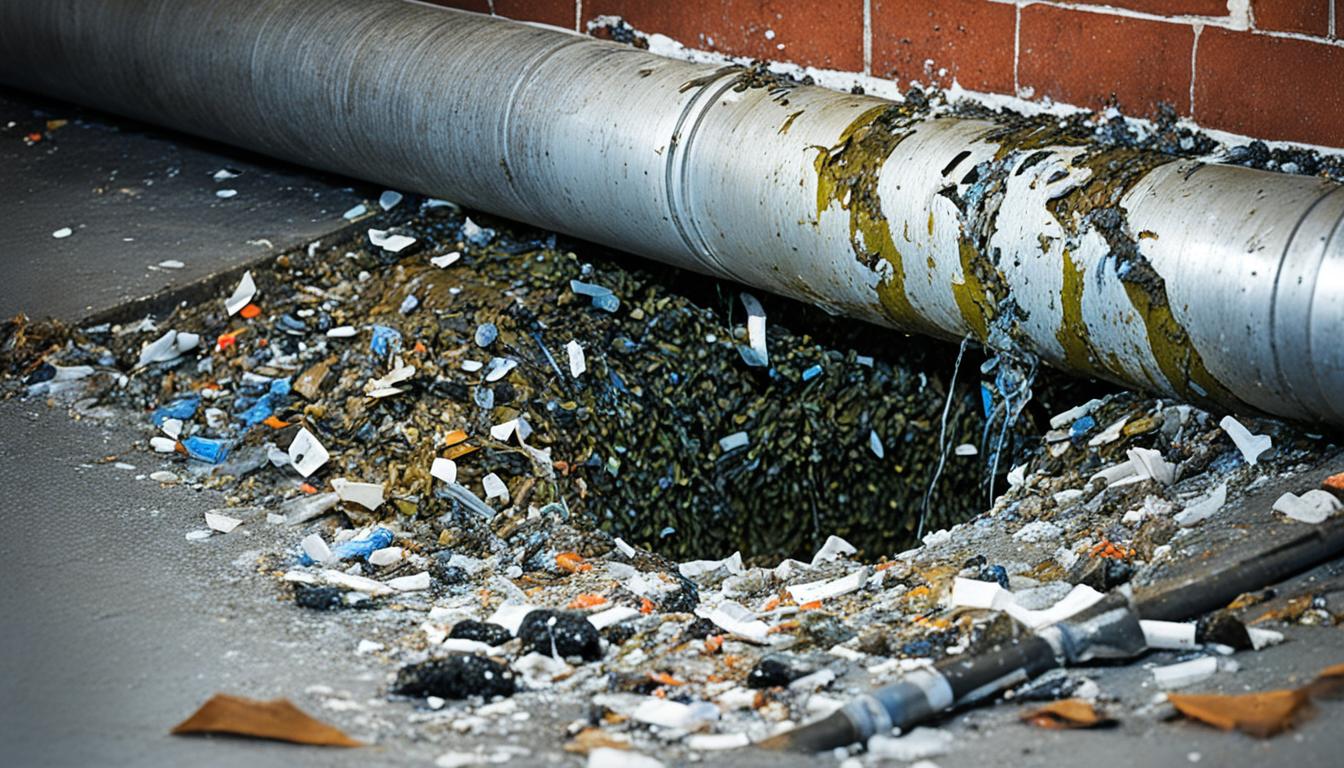Have you ever wondered what causes those unpleasant and messy sewage backups in homes? The answer may not be as simple as you think. While common blockages in the plumbing system are often to blame, there are other factors at play that can lead to sewage backups. Understanding the true causes is crucial in preventing this frustrating problem from occurring. So, what really causes sewage to back up?
In this article, we will explore the various reasons for sewage backups and shed light on the preventive measures you can take to avoid them. Whether it’s issues with the sewage system itself, common blockages in the plumbing system, or external influences, you’ll gain valuable insights into the causes and prevention of sewage backups.
Key Takeaways:
- Understanding the causes of sewage backups is essential in preventing them from occurring.
- Issues with the sewage system, common blockages, and external factors can all contribute to sewage backups.
- Aging sewer lines and a lack of regular maintenance can increase the risk of sewage backups.
- Regular maintenance, proper stormwater management, and prompt addressing of plumbing blockages can help minimize the risk of sewage backups.
- By taking proactive steps, homeowners can protect their properties from the inconvenience and potential health hazards associated with sewage backups.
Understanding the Sewage System and Its Function
The sewage system plays a crucial role in the proper management of wastewater and sewage in homes and buildings. It consists of various components that work together to ensure the efficient transportation and treatment of sewage. By understanding how the sewage system functions and the key components involved, homeowners can better identify potential issues and take appropriate preventive measures.
One of the essential components of the sewage system is the sewer main line, which acts as the central conduit for transporting sewage from individual properties to treatment facilities or septic tanks. The sewer pipes within a property, also known as lateral lines, collect wastewater from sinks, toilets, showers, and other drains, channeling it towards the main sewer line.
These sewer pipes and the main sewer line are typically made of durable materials such as PVC or cast iron to ensure longevity and prevent leaks. The sewer main line is buried underground and connects multiple properties, allowing for the efficient flow of sewage to the designated disposal or treatment area.
Additionally, some properties may have septic tanks as part of their sewage system. Septic tanks are large underground tanks that store and separate solid waste from the liquid effluent. The liquid portion is released into a drain field for further treatment and filtration, while the solid waste undergoes decomposition within the tank.
Understanding the function and interconnection of these components is crucial in maintaining an efficient and reliable sewage system. Regular maintenance and inspection of the sewer main line, lateral lines, and septic tanks can help identify potential blockages, leaks, or other issues that could lead to sewage backups and other problems.
Common Blockages and Their Impact on Sewage Flow
Blockages in the plumbing system are a common cause of sewage backups and can have a significant impact on sewage flow. There are several types of blockages that can occur, each with its own set of consequences. Understanding these blockages and their effects is essential in preventing backups and maintaining a properly functioning plumbing system.
- Tree Root Intrusion: One of the main culprits behind clogged sewer lines is tree roots. As trees grow, their roots can infiltrate the underground sewer pipes, causing blockages and hindering the flow of sewage. Over time, these intrusive roots can cause significant damage to the pipes, leading to costly repairs and backups.
- Grease Buildup: Another common plumbing blockage occurs when cooking grease is disposed of down the drain. Grease can solidify and accumulate inside the pipes, narrowing the passage for sewage to flow. This accumulation can slowly restrict the flow until a complete blockage occurs, resulting in sewage backups and potential pipe damage.
- Foreign Objects: Accidental or intentional flushing of foreign objects can cause blockages in the plumbing system. Items such as sanitary products, paper towels, and toys can get lodged in the pipes, obstructing the normal flow of sewage. These blockages can lead to backups and, in severe cases, require professional assistance to remove.
- Sediment Accumulation: Over time, sediment from debris, minerals, and other particles can settle in the plumbing pipes, causing gradual blockages. This sediment buildup restricts the flow of sewage, leading to backups and potential damage to the pipes. Regular maintenance and periodic cleaning can help prevent sediment accumulation and maintain proper sewage flow.
It is crucial to address these common plumbing blockages promptly to prevent further damage to the plumbing system and avoid the inconvenience of sewage backups. Regular inspections, proper waste disposal practices, and regular maintenance can help minimize the risk of clogged sewer lines and blocked drains.
External Factors Influencing Sewage Backups
External factors, such as heavy rain and flooding, can significantly contribute to sewage backups. When heavy rains occur, the excess water can overwhelm the sewage system, causing it to become overloaded and resulting in backups. This can be especially problematic in areas with inadequate stormwater management systems and improper grading around properties.
Proper stormwater management is crucial in preventing sewage backup during rain and sewage overflow during floods. Implementing effective drainage systems, such as rain gardens and permeable pavement, can help redirect and absorb excess rainwater, reducing the strain on the sewage system. Additionally, maintaining clear pathways for water flow and ensuring proper grading around properties can prevent water from pooling and contributing to sewage backups.
What Causes Sewage to Back Up?
Aging sewer infrastructure and a lack of regular maintenance can contribute significantly to sewage backups. Over time, sewer lines can deteriorate or become damaged, increasing the risk of blockages and backups. Without proper maintenance and inspections, potential issues may go unnoticed until a backup occurs. Regular maintenance and repairs can help prevent sewage backups caused by aging infrastructure.
To ensure the longevity and functionality of sewer lines, it is essential to prioritize sewer line maintenance. Regular inspections can identify early signs of deterioration, such as cracks, leaks, or tree root intrusion. By addressing these issues promptly, homeowners can prevent blockages and backups, minimizing the risk of sewage-related problems in their properties.
Moreover, deteriorating plumbing systems can also contribute to sewage backups. As pipes age, they may develop corrosion or scale buildup, further obstructing sewage flow. Regular maintenance, which includes cleaning and repairing sewer lines, can help alleviate these issues and maintain a healthy plumbing system.
In conclusion, the combination of aging sewer lines and a neglected plumbing system puts homeowners at a higher risk of sewage backups. Prioritizing sewer line maintenance and addressing deteriorating plumbing systems proactively can significantly reduce the chances of encountering unpleasant and costly sewage-related issues.
Conclusion
Preventing sewage backups is essential for homeowners to avoid the costly and disruptive consequences they can bring. By understanding the various causes of sewage backups, individuals can take proactive measures to protect their properties. Regular maintenance of the sewage system, prompt addressing of plumbing blockages, and proper stormwater management are crucial in reducing the risk of sewage backups.
To prevent sewage backups, homeowners should prioritize regular maintenance of their sewer infrastructure. This includes conducting routine inspections, identifying and repairing any damaged or deteriorating sewer lines, and clearing blockages promptly. By staying vigilant and addressing potential issues before they escalate, individuals can minimize the risk of backups.
In addition to maintenance, proper stormwater management plays a critical role in preventing sewage backups. Ensuring that property grading is appropriate, and that stormwater drains away from the sewage system can help alleviate the strain on the infrastructure during heavy rainfall or flooding events. By managing stormwater effectively, homeowners can reduce the likelihood of backups and overflows.
Furthermore, promptly addressing plumbing blockages is vital in preventing sewage backups. Common causes of blockages include tree root intrusion, grease buildup, foreign objects, and sediment accumulation. Homeowners should be proactive in identifying and clearing these blockages to maintain the flow of sewage through the plumbing system.
By following these sewage backup prevention tips, individuals can protect their properties from the inconvenience and potential health hazards associated with backups. Regular maintenance, proper stormwater management, and prompt addressing of plumbing blockages are key in maintaining a functional and efficient sewage system, thus minimizing the risk of sewage backups.






















